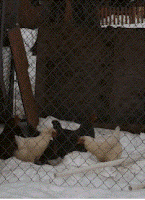THE COOP
You can go as fancy or as simple as you want. There are many places that you can go to buy chicken coops both online and locally. When we first decided to get chickens we drove from Binghamton to Oneonta looking and searching for coops. We looked in peoples backyards to get ideas...we went to every farm store in the area. The ones we found in the farm stores were all too small and too expensive. We searched Craigslist and at the time didn't find anything that we were really interested in. In the end, we ended up buy a coop with a run from AGWAY - some assembly required of course. Here is a picture of our coop:
This worked out great while they were little but once they started getting bigger they quickly outgrew it. I ended up moving the coop between our deck and our garage and putting a fence up so they had room to move around during the day. (by the way...chickens LOVE fresh grass). Once they outgrew this coop we knew we had to figure something out. The end of our garage had a overhang that we used to store the kids toys. Well the kids toys soon found a new home and so did my chickens. We put up a few sheets of plywood, cut a whole in the wall and pushed a dog kennel up to the side of the coop. VOILA....a new home for my chicks - they must of approved and liked it because a few days later I had my FIRST egg!!!!
COOP RULES
- SIZE = You need to allow a minimum of 2 square feet of indoor shelter area per bird (but ideally 3-4 feet is better), and you need 3-6 square feet of outdoor run area per bird.
- VENTILATION = A coop needs good ventilation year-round. Good ventilation usually consists of some way for cooler air to enter near the floor, be warmed, and then exit near the top. The amount of ventilation a shelter needs depends on how many chickens are kept in that amount of space and the weather in your area. Lack of adequate ventilation can cause a number of problems (ammonia fume buildup, increased humidity, increased moisture leads to mold
- ROOSTS = Roosts are an important part of a coop. This is where they sleep - chickens prefer to sleep off of the ground because they are so vulnerable while asleep. A 2x4 on edge or a 2-inch round wooden dowel is about right for full-sized chickens. (smaller Bantam chickens will be more comfortable with a small roost). The roost should be placed about 2 feet off the floor.
- NESTING BOXES = these are important if your keeping chickens for their eggs. They provide a safe and comfortable spot where layers can lay their eggs. Young pullets like to play house so if possible, try to have nesting boxes in place by 20 weeks old. Chickens like nesting boxes that are big enough to turn around in but not so large that they don't feel comfy. They prefer the nesting boxes to be dimly lit and secluded . For an average sized hen, a 12-inch square nest box is the minimum to use. One nest box for every two hens is ideal. We made our own nesting boxes and even though we have 10 chickens, we only have 3 nesting boxes. This is probably something we should work on in the future. We use pine bedding and hay in our nesting boxes - although the chickens usually kick the hay out...they prefer the pine bedding.
PLEASE CONTINUE TO ASK QUESTIONS - EVERY MONDAY I WILL TRY TO DO A POST THAT JUST ANSWERS MY READERS QUESTIONS!!!!
RESOURCES: Most of this information is from my experiences. I also used the book "Raising Chicken for Dummies". You can also find great information at the following places (where I go to for answers and help):












1 comments:
Stopping by from Bloggy Moms. Following you now with GFC. I don’t need a blog follow but I would appreciate a “like” at my FB page:
http://www.facebook.com/halcyonshore
Please make sure to “like” when signed in as a person rather than as a page. It doesn’t count if it’s not a person.
Lynn Tillman
Post a Comment